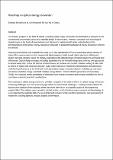Roadmap on optical energy conversion
Author(s)
Boriskina, Svetlana V; Green, Martin A; Catchpole, Kylie; Yablonovitch, Eli; Beard, Matthew C; Okada, Yoshitaka; Lany, Stephan; Gershon, Talia; Zakutayev, Andriy; Tahersima, Mohammad H; Sorger, Volker J; Naughton, Michael J; Kempa, Krzysztof; Dagenais, Mario; Yao, Yuan; Xu, Lu; Sheng, Xing; Bronstein, Noah D; Rogers, John A; Alivisatos, A Paul; Nuzzo, Ralph G; Gordon, Jeffrey M; Wu, Di M; Wisser, Michael D; Salleo, Alberto; Dionne, Jennifer; Bermel, Peter; Greffet, Jean-Jacques; Celanovic, Ivan; Soljacic, Marin; Manor, Assaf; Rotschild, Carmel; Raman, Aaswath; Zhu, Linxiao; Fan, Shanhui; Chen, Gang; ... Show more Show less
DownloadRoadmap-on-Optical-Energy-Conversion.pdf (3.336Mb)
PUBLISHER_POLICY
Publisher Policy
Article is made available in accordance with the publisher's policy and may be subject to US copyright law. Please refer to the publisher's site for terms of use.
Terms of use
Metadata
Show full item recordAbstract
For decades, progress in the field of optical (including solar) energy conversion was dominated by advances in the conventional concentrating optics and materials design. In recent years, however, conceptual and technological breakthroughs in the fields of nanophotonics and plasmonics combined with a better understanding of the thermodynamics of the photon energy-conversion processes reshaped the landscape of energy-conversion schemes and devices. Nanostructured devices and materials that make use of size quantization effects to manipulate photon density of states offer a way to overcome the conventional light absorption limits. Novel optical spectrum splitting and photon-recycling schemes reduce the entropy production in the optical energy-conversion platforms and boost their efficiencies. Optical design concepts are rapidly expanding into the infrared energy band, offering new approaches to harvest waste heat, to reduce the thermal emission losses, and to achieve noncontact radiative cooling of solar cells as well as of optical and electronic circuitries. Light–matter interaction enabled by nanophotonics and plasmonics underlie the performance of the third- and fourth-generation energy-conversion devices, including up- and down-conversion of photon energy, near-field radiative energy transfer, and hot electron generation and harvesting. Finally, the increased market penetration of alternative solar energy-conversion technologies amplifies the role of cost-driven and environmental considerations. This roadmap on optical energy conversion provides a snapshot of the state of the art in optical energy conversion, remaining challenges, and most promising approaches to address these challenges. Leading experts authored 19 focused short sections of the roadmap where they share their vision on a specific aspect of this burgeoning research field. The roadmap opens up with a tutorial section, which introduces major concepts and terminology. It is our hope that the roadmap will serve as an important resource for the scientific community, new generations of researchers, funding agencies, industry experts, and investors.
Date issued
2016-06Department
Massachusetts Institute of Technology. Department of Mechanical EngineeringJournal
Journal of Optics
Publisher
IOP Publishing
Citation
Boriskina, Svetlana V; Green, Martin A; Catchpole, Kylie; Yablonovitch, Eli; Beard, Matthew C; Okada, Yoshitaka; Lany, Stephan, et al. “Roadmap on Optical Energy Conversion.” Journal of Optics 18, 7 (June 2016): 073004 © 2016 IOP Publishing Ltd
Version: Author's final manuscript
ISSN
0150-536X
2040-8986